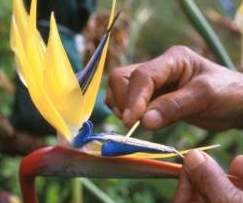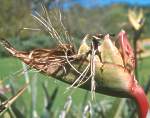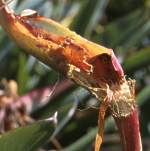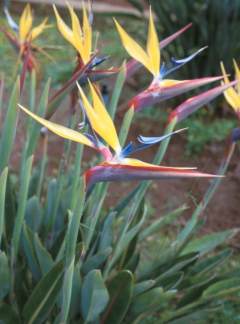Strelitzia reginae 'Mandela's Gold'
Strelitzia reginae Aiton 'Mandela's Gold'
Family: Strelitziaceae
Common names: Mandela's Gold strelitzia, yellow strelitzia, yellow crane flower, yellow bird of paradise, geelkraanvoel blom, geel piesang
Introduction
Strelitzia reginae 'Mandela's Gold' is a rare yellow form of the well-known crane flower, Strelitzia reginae.

Description
Description
'Mandela's Gold' is a stemless, evergreen clump-forming perennial. Greyish green, banana-like leaves grow to a height of about 1.5 m and during winter and spring the large bird-like flowers are held above the foliage on the tips of long, sturdy stalks. The structure and pollination of the flowers is fascinating. The hard, beak-like sheath from which the flower emerges, is called the spathe. This is held at right angles to the stem, and has the appearance of a bird's head.
Each spathe contains 4 to 6 flowers, and these emerge one at a time from the spathe. Each flower consists of 3 clear yellow sepals and 3 deep purple petals. The yellow sepals give the appearance of a crest on the 'bird's' head. Two of the purple petals are joined together around the stamens and the style to form an arrow-like structure. The third purple petal is visible as a small scale.
Derivation of name and historical aspects
History
Yellow-flowering strelitzias have been known for a number of years, plants have cropped up in France, California, Australia, Japan and in South Africa at a few locations in Eastern Cape and at Kirstenbosch and the Karoo Desert National Botanical Garden, but always as isolated specimens. Left to their own devices, the seeds from these yellow forms will not breed true as they will most likely have been pollinated by an orange plant. To get yellow progeny, two yellow plants must be crossed.
At Kirstenbosch in the 1970s, there were seven yellow plants in the nursery. John Winter, who was curator during this period, began a project to increase the stock. It took nearly twenty years of careful selection and hand-pollination, and in 1994 the original stock had been built up enough to enable us to introduce the yellow strelitzia to horticulture. It was released and traded under the name 'Kirstenbosch Gold' until 1996 when the NBI was granted permission to re-name it in honour of Nelson Mandela.
Ecology
Ecology
Nectar is produced by a gland at the base of the flower. In fact, so much nectar is produced that it leaks out and drips down the side of the spathe. Although it is not certain exactly which bird is the pollinator, when it comes to feed on the nectar, it perches on the arrow-like purple petals, which open to expose the anthers and the sticky pollen adheres to the feet of the bird. The bird then transfers this pollen to the stigma of the next flower it visits.

The pollinator does not live in Cape Town and we get absolutely no seed unless we hand-pollinate. This appeared to be a curse at first but is actually a blessing, as we can be 100% sure that our seed is 100% pure yellow. In areas where the pollinator lives, to ensure 100% purity, the yellow plants would have to be physically enclosed or separated from any orange plants in the vicinity.
Hand pollination is done by mimicking the action of the bird, i.e. using a stick or a finger to depress the purple petals to expose the anthers, scraping some pollen off and transferring it to a receptive (shiny and sticky) stigma on another plant. After fertilization, the fruits develop inside the spathe. As they ripen, the capsules swell and protrude from the spathe, change from green, to brown and woody, and split to release the distinctive shiny black seeds with their tuft of oily orange hairs (the aril).

At Kirstenbosch, the grey squirrel that Cecil John Rhodes brought with him from England, Sciurus carolinensis, which has naturalized itself here, will consume nearly all the crop if unchecked. It takes the entire, almost-ripe green capsule, leaving nothing but the vandalized remains of the spathe behind. We have battled for years to find the best way of protecting our developing seed, and short of erecting a cage around the plants in the garden, we have found that enclosing each fertilized flower in fine-mesh chicken wire keeps the squirrels out.

Growing Strelitzia reginae 'Mandela's Gold'
Grow
Strelitzia reginae 'Mandela's Gold' is an easy plant to grow and will thrive in most soils.
Ideal conditions are full sun, rich, well-drained loam soil with a pH of approximately 7.5, regular deep watering in summer and liberal applications of fertilizer in early summer. Bonemeal and plenty of mature compost should be mixed into the soil when planting. Plants will respond well to generous applications of manure and compost or additional fertilizer watered in about once a month during summer. A fertilizer with the proportions 3:1:5 encourages flowering, and can be alternated with other formulations.
In South Africa and other sunny countries, strelitzias will also do well in semi-shade, but in less sunny regions, they need as much sun as they can get if they are to flower well. Once established, they can survive with very little water, and they are tolerant of wind and coastal conditions. But 'Mandela's Gold' is sensitive to cold and needs a sheltered position against a north- or west-facing wall in areas that experience frost, and is not suitable for permanent outdoor cultivation in regions that experience a winter low of -7 to -1 ºC / 30 to 40 ºF (zone 9) or lower.

'Mandela's Gold' is a striking feature plant, a decorative garden subject and adds a tropical feel to courtyards and swimming pool areas. It is also an excellent cutflower. It is suitable for cultivation in large tubs and containers but for better flowering performance it should then be fed with a dilute liquid fertilizer at least every second week, particularly at the beginning of the growing season. In cold climates it can be grown in a sunny or brightly-lit conservatory.
Propagation is by seed or division. The plants are slow-growing and large clumps that are split or moved will take at least two years to re-establish themselves and flower again. To get a mature flowering plant from seed: under ideal conditions it takes about 3 years; but under less than ideal conditions it can take from 5 to 7 years. For best results sow fresh seed in spring or early summer. To improve germination, the seed can be soaked in a solution of ethrel, but this treatment is not necessary for germination to occur. Without ethrel treatment approx. 50% of the seed should germinate in 4 to 8 weeks with a further 30% germinating sporadically for up to one year after sowing. With ethrel treatment, 80% of the seeds should germinate within the first 4 to 8 weeks.
Before sowing, remove the bright orange aril and soak the seed in a solution of ethrel at a concentration of 2000 ppm active constituent, for 48 hours. Sow in seedtrays filled with a well-drained soil medium at a depth of 1 to 1½ times the size of the seed. A constant temperature of 25ºC is most suitable for germination as low temperatures retard germination. Seedlings should be a good size before being transplanted (two to three leaves) into a well-drained potting medium. In our nursery we have found that the young plants are best grown in semi-shade, as the leaves tend to burn in direct sunlight. Regular repotting allows the young plant to develop rapidly. Restricting the root development retards growth.
References
- Winter, J. 1994. Going for Gold. Veld & Flora 80,1: 22, 23.
Credits
Alice Notten
Kirstenbosch National Botanical Garden
August 2002
Plant Attributes:
Plant Type: Shrub
SA Distribution: Eastern Cape
Soil type: Loam
Flowering season: Spring, Early Summer, Winter
PH:
Flower colour: Blue, Yellow
Aspect: Full Sun
Gardening skill: Easy
Special Features:
Horticultural zones











Rate this article
Article well written and informative
Rate this plant
Is this an interesting plant?
Login to add your Comment
Back to topNot registered yet? Click here to register.